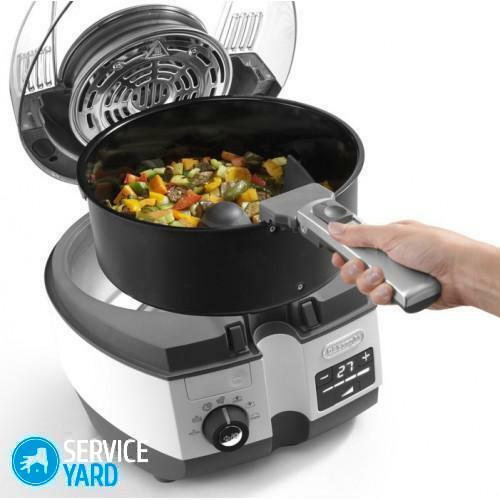Autonomous water supply in a private house is a real boon, especially at current prices for utilities. So many owners of suburban areas are thinking about drilling a well and having their own free water for all household needs. Now on sale there are many different devices that can ensure the smooth operation of a private source. But in fact, the simplest and most trouble-free is a manual pump for water from a well. It is guaranteed to work even in the absence of electricity, it will not burn out or break. It remains only to figure out which type of this device to choose and how to install it.
Read in the article
- 1 Advantages and disadvantages of hand pumps for wells
- 2 Types of hand pumps for a well and their features
- 2.1 Vane pumps
- 2.2 Piston pumps
- 2.3 Rod pumps
- 2.4 Diaphragm pumps
- 3 How to choose a hand pump for a well
- 4 Ready-made models of hand pumps
- 5 The nuances of installing hand pumps on water
- 6 How to make a hand pump for a well with your own hands
Advantages and disadvantages of hand pumps for wells
All hand pumps must meet one important requirement: they must pump water with minimal effort. Yes, there will be no such pressure as with an electric pump, but there will also be no energy consumption, so there is an opportunity to save.
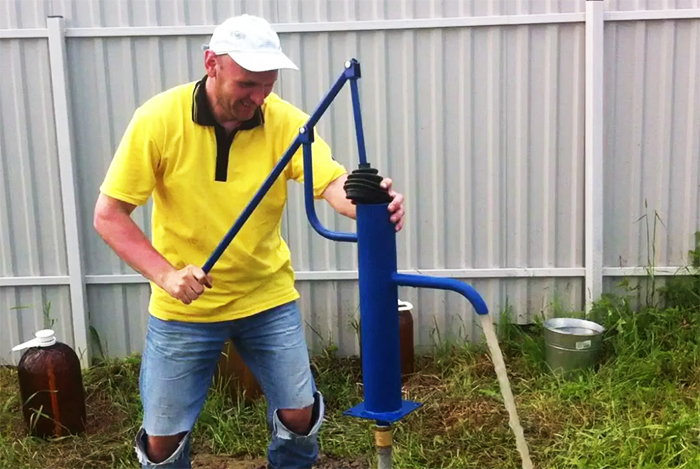
Advantages of hand pumps for wells:
- complete autonomy - these speakers do not require an electrical connection, so you can use them even in areas where, in principle, there is no network;
- low cost of the device itself - even a factory-made design is cheaper than an electrical counterpart, and if you make it yourself, the costs will be minimal;
- versatility in use - hand pumps are suitable for both shallow and deep wells;
- high maintainability - due to the simple design, the pumps have a minimum of interchangeable parts;
- simple installation - you can install a water hand pump yourself, without the involvement of third-party specialists and the use of professional equipment;
- ease of operation - these mechanical pumps are controlled by a simple lever, which even a child can handle.
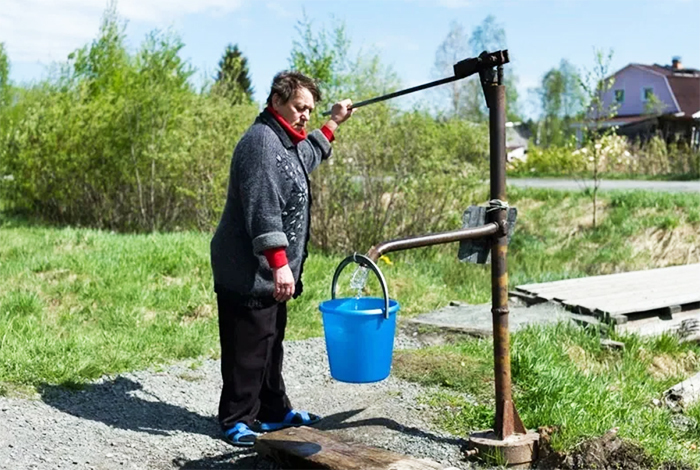
The performance of hand pumps is not high, but, again, this is only a problem when large volumes are needed. If you need a pump in order to have water for a couple of flower beds in the yard, this is one thing, and quite the other is if you have a large garden where a large volume is required for daily watering moisture. On average, a hand pump for a well can draw up to 40 liters of water per minute.
Types of hand pumps for a well and their features
It should be noted that hand pumps for wells are sold in carved, in terms of materials, designs. Plastic, the cheapest devices are suitable for seasonal pumping of water, but they are not durable and often fail. They are not left for the winter, so this is a great option for giving.
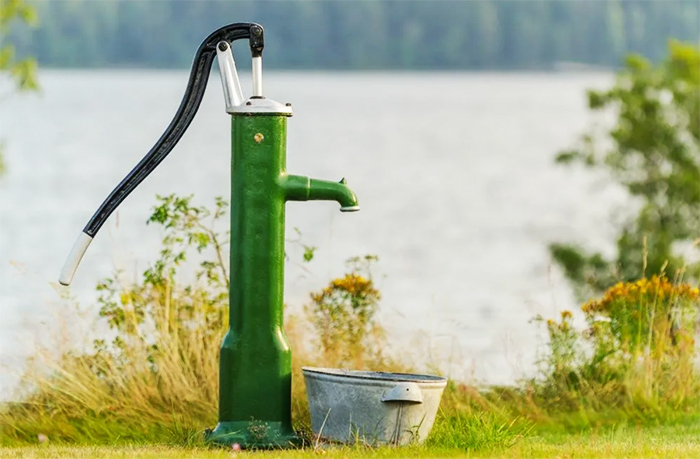
Hand pumps come in different types: diaphragm, piston, vane, rod. Each of these varieties has its own characteristics of operation.
Vane pumps
Vane pumps are miniature and allow pumping water from a depth of up to 7 meters from a clean well. These small models are great for indoors if the well is located right in the house.
The device of the vane pump: a casing with two branch pipes, an impeller with blades, valves at the inlet and outlet in the chambers, a flange.

By the way, pumps of this type are used not only for water - they are also suitable for thick and viscous liquids, but not contaminated.
Most often on sale you will find vane pumps made of anodized metal, but there are, for example, bronze ones, which have amazing resistance to corrosion. Such models can be safely called eternal.
Piston pumps
Piston hand pumps for wells are very popular with owners of suburban areas.
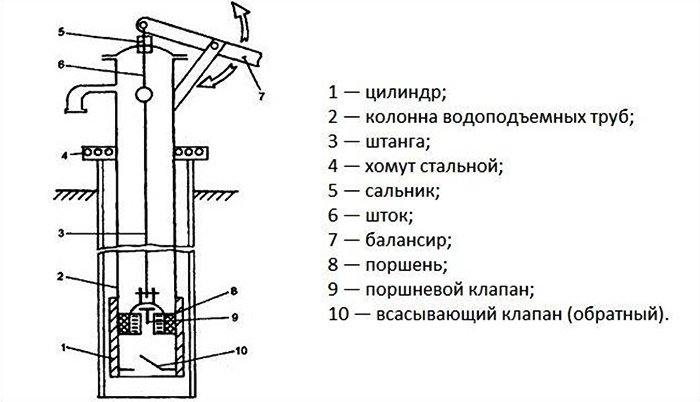
Devices of this type are installed at a slight elevation and are suitable for wells in which the water surface is raised to a sufficient height. The piston pump does an excellent job with wells up to 10 meters.
The principle of operation of a piston pump is very simple: when the lever is pressed, the piston moves, the water rises under pressure and, thanks to the check valve, can no longer pour back into the well.
Piston pumps are suitable for wells with clean water or small amounts of fine sand.
Piston pumps require periodic maintenance, which consists in changing gaskets and seals. By the way, a piston pump is very easy to make with your own hands from improvised materials.
Rod pumps
Rod pumps have a second common name - rod pumps. They are used in wells up to 20-30 meters deep, that is, the rod pump copes with great depths, unlike all other models.
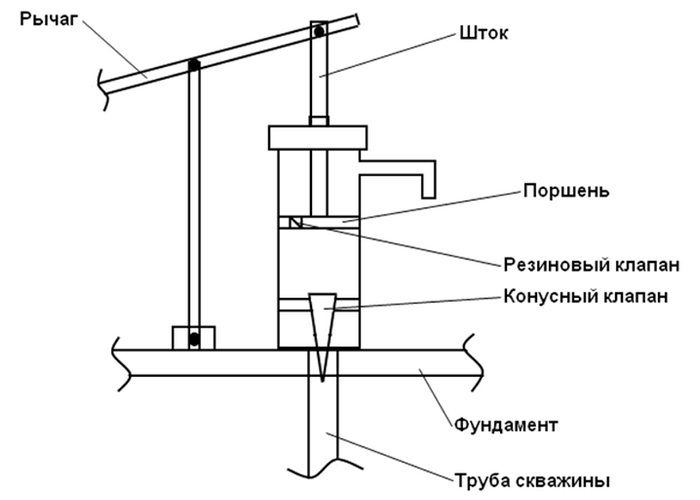
Otherwise, the principle of operation of the rod pump is the same as that of the cylinder. The main condition for successful operation is an absolutely even vertical structure of the well. On wells with inclination and bends, the device will not work successfully.
The main reason for choosing a rod pump is the need to lift water from great depths in conditions where an electric pump cannot be used for some reason. Compact pumps of this type are easy to manufacture and may well be made from improvised materials.
The disadvantage of a rod pump is the difficulty in installation and the fundamental value of the design. In addition, it is quite difficult to swing it, considerable physical effort is required.
Diaphragm pumps
Membrane or, as they are also called, diaphragm devices can be safely called more modern and convenient to use. They can pump both clean and dirty water, even if there is an abrasive in the contents. The whole secret of such “omnivorousness” is in ball valves that do not jam and do not come into contact with each other. The spherical shape allows dirt not to linger on the surface of the valves.

How to choose a hand pump for a well
So, which of the presented types of manual control pumps to choose for your site and well?
The first and most important thing to pay attention to is the depth of your well. If the well is relatively shallow, up to 7 meters, you can choose any pump model.
If the water is located at a depth of 10 meters, you can choose a rod, piston and diaphragm pump, vane is not suitable. With a depth of up to 30 meters, only a rod structure is suitable, and then on condition of the absolute verticality of the well.
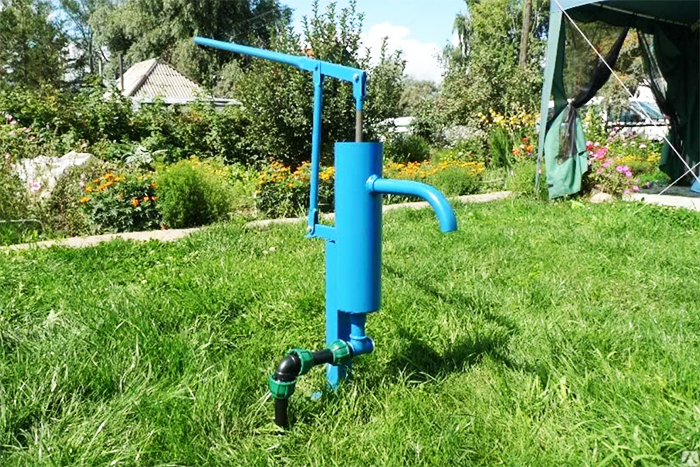
There are some nuances when choosing to transport the device. Simple models weighing up to 15 kg are easy to bring in the trunk of a car, but equipment weighing 130 kg will require not only suitable transport, but also a crane for loading and unloading.
Large heavy models are not easy to install yourself, so a crane may be required for installation. You should think about this in advance, so that later in a panic you do not hire him repeatedly.
One of the criteria for choosing the type of pump is the quality of the water. Not every unit is able to cope with a liquid containing, for example, sand or other impurities.
For wells in which water can hardly be called clean, piston, membrane and rod units are more suitable - they will cope with the presence of sand and small contaminants.

For wells in seasonal dachas, it makes no sense to purchase expensive models - a plastic construction is quite suitable, which can be removed for storage for the winter by mothballing the water source. For long-term and reliable operation, it is worth giving preference to cast-iron and bronze models, which will cost a lot, but with this will also serve your grandchildren and will be able to be used not only in warm weather, but also in winter, in the most severe frosts (provided insulation).
For many owners, the appearance of the pump matters when making a decision. In this case, when buying, you need to pay attention to the presence of decorative elements, stylish handles and figured taps. Such hand pumps can become a real art object on your site.

When choosing a device, it makes sense to pay attention to models with a self-cleaning function - such pumps require minimal attention and do without additional maintenance.
Ready-made models of hand pumps
There are currently several manufacturers of manual borehole pumps on the Russian market:
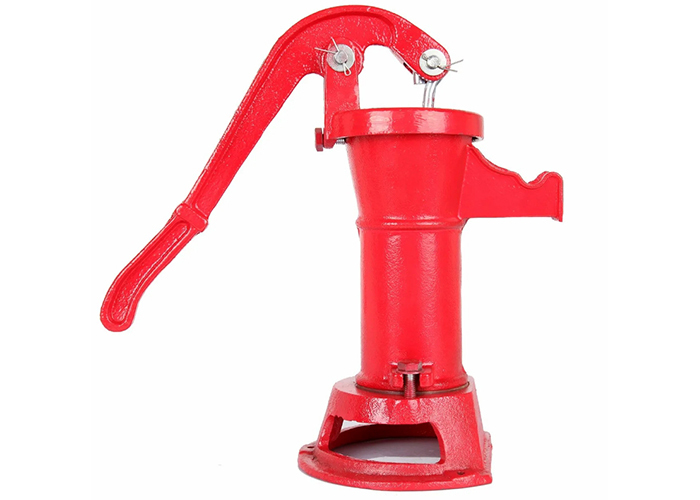
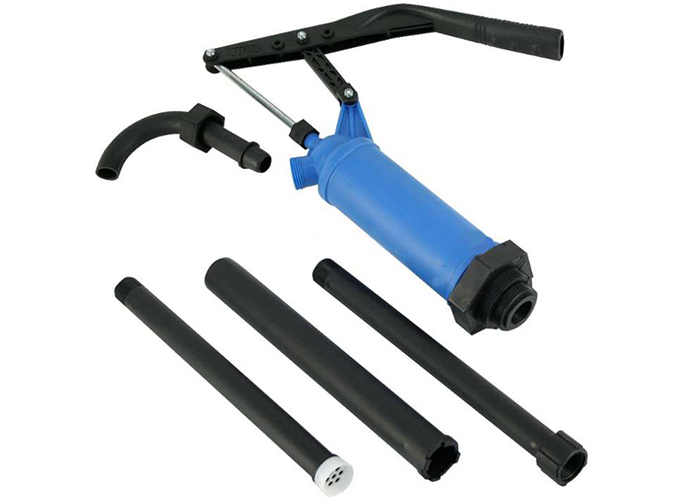
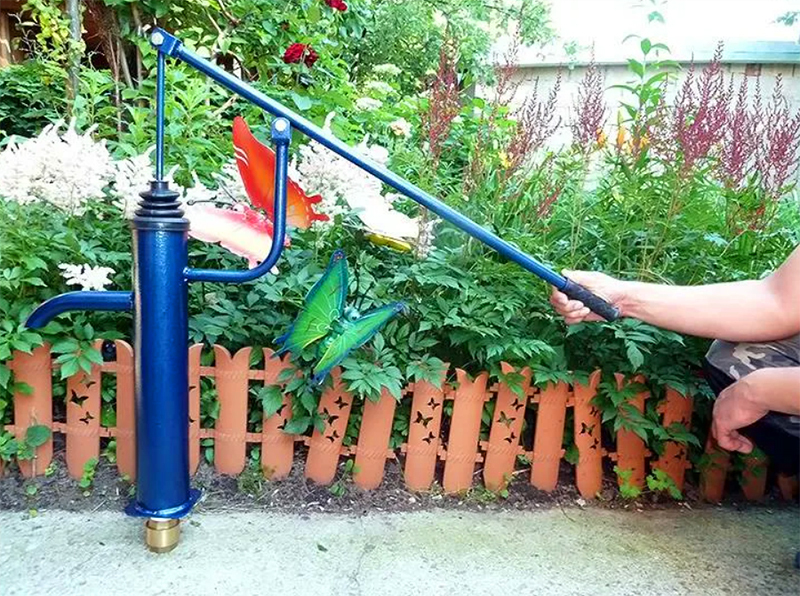
The nuances of installing hand pumps on water
It makes no sense to buy a pump until you make a well. During the drilling process, various nuances may appear that can significantly affect your choice. In addition, it is impossible to know in advance exactly at what depth the aquifer will lie, so it makes no sense to purchase a device for pumping water in advance. First you need to drill a well and find out to what maximum height the pump can raise water.
On average, the depth of aquifers is from 5 to 8 meters, depending on the terrain. You can find water in shallower layers of the soil, but, as a rule, it will be heavily polluted, so it will not be suitable for all household needs.

By itself, the installation of a hand pump is extremely simple: a structure is installed on the threaded head of the pipe, without first forgetting about the check valve. For stability, the pump should be additionally fixed on a solid metal welded stand.
How to make a hand pump for a well with your own hands
Taking into account the fact that the designs of hand pumps are extremely simple, it is not difficult to make them yourself, even with a modest knowledge of the mechanisms. The simplest and most inexpensive pump can be made from sewer pipes, they will act as a working body. And let the piston system be better metal.
An example of the manufacture of such a pump for a well is in this video:
Approximate pump design:
- For the manufacture of the body of a hand pump, you can use a sleeve from the motor and a piece of metal pipe 60–80 cm long and at least 80 mm in diameter. The inside of the sleeve should be as smooth as possible - this will increase the efficiency of the device.
- The pump cover can be plastic or metal - it does not matter, the main thing is that it has a hole for the stem and for the valve.
- The piston for the pump can be made of plastic or, more simply, of wood or metal. The main thing is to provide it with a sealing rubber gasket for complete tightness of the structure. Only in this way will you ensure a normal water pressure.
- The rod for a rod pump can be made from a rigid plastic pipe.
As you can see, the design is quite primitive and will not cause you any difficulties, especially if you have a clear assembly scheme. And for the manufacture of such a unit will not require complex tools or knowledge in mechanics. No wonder such hand pumps for water used to be in all villages and were used not only for wells, but also for wells. Why not remember the old, especially since you can always upgrade the mechanical design into an electrical one if you wish - this is also possible.
Have you personally used hand pumps for wells? What is your opinion about them? Share in the comments!
I've been looking at buying a sauna for a long time. I recently found exactly that one at an exhibition in Zyablikovo ...
A friend designed a garage for me. It remains only to find a team for implementation. Well on…
Guys, it's not complete. You don't mention Domorost, but still these guys have a problem...
Hello, thank you for the informative information. Health to you and your loved ones. Sk…
From strong winds, fences sometimes fall if they are installed unreliably. We have our own at Terem-p ...
We bought a summer cottage with a dilapidated country house. They restored it through the tower. AND …
The tm film and the zebra have nothing to do with PLEN, do not mislead people ...
We need this Vodonaeva with her cats like fifth leg dogs.
I need to make a Christmas tree out of cardboard for the office. If you do this please give me a call...
Don't chase the blizzard... In your opinion, all the great writers were prostitutes. Go...
Hello! And how can you make a cone planter for flowers, or rather, how to fasten the cone?
Four days ago I ordered a Revolts heating kit for our dacha. I'm going to pick up tomorrow...
If the apartment is ready, then why doesn’t Buzova broadcast to the whole world about moving and living ...
Like 10m. Enough tape for 1.5m of fence?!
This is most likely an Internet modem like yota. And, I remember, they used both polarizers ...



